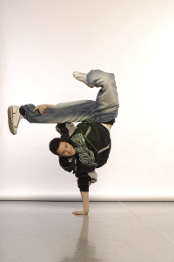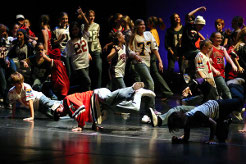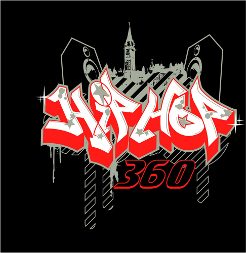| |  Hip hop is a music genre and cultural movement which developed in New York City in the early 1970s primarily among African Americans and Latino Americans. Hip Hop's four main elements are MCing (often called rapping), DJing, graffiti writing, and breakdancing. Other elements include beatboxing, hip hop fashion, and slang. Since first emerging in the Bronx, the lifestyle of hip hop culture has spread around the world. Hip hop is a music genre and cultural movement which developed in New York City in the early 1970s primarily among African Americans and Latino Americans. Hip Hop's four main elements are MCing (often called rapping), DJing, graffiti writing, and breakdancing. Other elements include beatboxing, hip hop fashion, and slang. Since first emerging in the Bronx, the lifestyle of hip hop culture has spread around the world.
When hip hop music began to emerge, it was based around disc jockeys who created rhythmic beats by looping breaks (small portions of songs emphasizing a percussive pattern) on two turntables. This was later accompanied by "rapping" (a rhythmic style of chanting). An original form of dancing, and particular styles of dress, arose among followers of this new music. These elements experienced considerable refinement and development over the course of the history of the culture.
The relationship between graffiti and hip hop culture arises from the appearance of new and increasingly elaborate and pervasive forms of the practice in areas where other elements of hip hop were evolving as art forms, with a heavy overlap between those who wrote graffiti and those who practiced other elements of the culture. Beatboxing is a vocal technique mainly used to imitate percussive elements of the music and various technical effects of hip hop DJs.
• Breaking
 Breaking, also breakdancing or B-boying, is a dynamic style of dance which developed as part of the hip hop culture. Breaking began to take form in the South Bronx alongside the other elements of hip hop. The "B" in B-boy stands for break, as in break-boy (or girl). The term "B-boy" originated from the dancers at DJ Kool Herc's parties, who saved their best dance moves for the break section of the song, getting in front of the audience to dance in a distinctive, frenetic style. According to the documentary film The Freshest Kids: A History of the B-Boy, DJ Kool Herc describes the "B" in B-boy as short for breaking which at the time was slang for "going off", also one of the original names for the dance. However, early on the dance was known as the "boiong" (the sound a spring makes). Breaking was briefly documented for release to a world wide audience for the first time in Style Wars, and was later given a little more focus in the fictional film Beat Street. Early acts include the Rock Steady Crew and New York City Breakers. Breaking, also breakdancing or B-boying, is a dynamic style of dance which developed as part of the hip hop culture. Breaking began to take form in the South Bronx alongside the other elements of hip hop. The "B" in B-boy stands for break, as in break-boy (or girl). The term "B-boy" originated from the dancers at DJ Kool Herc's parties, who saved their best dance moves for the break section of the song, getting in front of the audience to dance in a distinctive, frenetic style. According to the documentary film The Freshest Kids: A History of the B-Boy, DJ Kool Herc describes the "B" in B-boy as short for breaking which at the time was slang for "going off", also one of the original names for the dance. However, early on the dance was known as the "boiong" (the sound a spring makes). Breaking was briefly documented for release to a world wide audience for the first time in Style Wars, and was later given a little more focus in the fictional film Beat Street. Early acts include the Rock Steady Crew and New York City Breakers.
B-boying is one of the major elements of hip hop culture, commonly associated with, but distinct from, "popping", "locking", "hitting", "ticking", "boogaloo", and other funk styles that evolved independently during the late 1960s in California. It was common during the 1980s to see a group of people with a radio on a playground, basketball court, or sidewalk performing a B-boy show for a large audience.
• Graffiti
 In America around the late 1960s, graffiti was used as a form of expression by political activists, and also by gangs such as the Savage Skulls, La Familia, and Savage Nomads to mark territory. Towards the end of the 1960s, the signatures-tags-of Philadelphia graffiti writers Top Cat, Cool Earl and Cornbread started to appear. Around 1970-71, the centre of graffiti innovation moved to New York City where writers following in the wake of TAKI 183 and Tracy 168 would add their street number to their nickname, "bomb" a train with their work, and let the subway take it-and their fame, if it was impressive, or simply pervasive, enough-"all city". Bubble lettering held sway initially among writers from the Bronx, though the elaborate Brooklyn style Tracy 168 dubbed "wildstyle" would come to define the art. The early trendsetters were joined in the 70s by artists like Dondi, Futura 2000, Daze, Blade, Lee, Zephyr, Rammellzee, Crash, Kel, NOC 167 and Lady Pink In America around the late 1960s, graffiti was used as a form of expression by political activists, and also by gangs such as the Savage Skulls, La Familia, and Savage Nomads to mark territory. Towards the end of the 1960s, the signatures-tags-of Philadelphia graffiti writers Top Cat, Cool Earl and Cornbread started to appear. Around 1970-71, the centre of graffiti innovation moved to New York City where writers following in the wake of TAKI 183 and Tracy 168 would add their street number to their nickname, "bomb" a train with their work, and let the subway take it-and their fame, if it was impressive, or simply pervasive, enough-"all city". Bubble lettering held sway initially among writers from the Bronx, though the elaborate Brooklyn style Tracy 168 dubbed "wildstyle" would come to define the art. The early trendsetters were joined in the 70s by artists like Dondi, Futura 2000, Daze, Blade, Lee, Zephyr, Rammellzee, Crash, Kel, NOC 167 and Lady Pink
The relationship between graffiti and hip hop culture arises both from early graffiti artists practicing other aspects of hip hop, and its being practiced in areas where other elements of hip hop were evolving as art forms. Graffiti is recognized as a visual expression of rap music, just as breakdancing is viewed as a physical expression. The book Subway Art (New York: Henry Holt & Co, 1984) and the TV program Style Wars (first shown on the PBS channel in 1984) were among the first ways the mainstream public were introduced to hip hop graffiti.
| |



